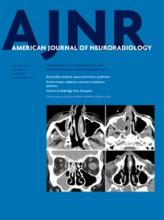Research ArticleFunctional
Open Access
Influence of Resting-State Network on Lateralization of Functional Connectivity in Mesial Temporal Lobe Epilepsy
L. Su, J. An, Q. Ma, S. Qiu and D. Hu
American Journal of Neuroradiology August 2015, 36 (8) 1479-1487; DOI: https://doi.org/10.3174/ajnr.A4346
L. Su
aFrom the College of Mechatronics and Automation (L.S., Q.M., D.H.), National University of Defense Technology, Changsha, Hunan, People's Republic of China
cDepartment of Information Engineering (L.S.), Officers College of Chinese Armed Police Force, Chengdu, Sichuan, China.
J. An
bDepartment of Medical Imaging (J.A., S.Q.), First Affiliated Hospital of Guangzhou University of Chinese Medicine, Guangzhou, Guangdong, People's Republic of China
Q. Ma
aFrom the College of Mechatronics and Automation (L.S., Q.M., D.H.), National University of Defense Technology, Changsha, Hunan, People's Republic of China
S. Qiu
bDepartment of Medical Imaging (J.A., S.Q.), First Affiliated Hospital of Guangzhou University of Chinese Medicine, Guangzhou, Guangdong, People's Republic of China
D. Hu
aFrom the College of Mechatronics and Automation (L.S., Q.M., D.H.), National University of Defense Technology, Changsha, Hunan, People's Republic of China

References
- 1.↵
- Mueller SG,
- Laxer KD,
- Barakos J, et al
- 2.↵
- Engel J Jr.
- 3.↵
- Spencer SS
- 4.↵
- 5.↵
- 6.↵
- Voets NL,
- Beckmann CF,
- Cole DM, et al
- 7.↵
- 8.↵
- Bettus G,
- Bartolomei F,
- Confort-Gouny S, et al
- 9.↵
- Bettus G,
- Guedj E,
- Joyeux F, et al
- 10.↵
- 11.↵
- Mueller SG,
- Laxer KD,
- Cashdollar N, et al
- 12.↵
- 13.↵
- Zhang Z,
- Liao W,
- Chen H, et al
- 14.↵
- Dosenbach NU,
- Nardos B,
- Cohen AL, et al
- 15.↵
- Lüders H
- Meencke H,
- Veith G
- 16.↵
- Achard S,
- Salvador R,
- Whitcher B, et al
- 17.↵
- Lee MH,
- Smyser CD,
- Shimony JS
- 18.↵
- 19.↵
- Repovs G,
- Csernansky JG,
- Barch DM
- 20.↵
- Bright P
- Tedeschi G,
- Esposito F
- 21.↵
- Guyon I
- 22.↵
- De Martino FD,
- Valente G,
- Staeren N, et al
- 23.↵
- Vapnik V
- 24.↵
- Fawcett T
- 25.↵
- Focke NK,
- Yogarajah M,
- Bonelli SB, et al
- 26.↵
- Bernhardt BC,
- Chen Z,
- He Y, et al
- 27.↵
- Friston KJ,
- Frith CD
- 28.↵
- Shen H,
- Wang L,
- Liu Y, et al
- 29.↵
- Gong Q,
- Wu Q,
- Scarpazz C, et al
- 30.↵
- Haynes JD,
- Rees G
- 31.↵
- 32.↵
- Zhang Z,
- Lu G,
- Zhong Y, et al
- 33.↵
- Greicius MD,
- Flores BH,
- Menon V, et al
- 34.↵
- Buckner RL,
- Andrews-Hanna JR,
- Schacter DL
- 35.↵
- Zhang Z,
- Lu G,
- Zhong Y, et al
- 36.↵
- Liao W,
- Zhang Z,
- Pan Z, et al
- 37.↵
- 38.↵
- Luo C,
- Qiu C,
- Guo Z, et al
- 39.↵
- Dosenbach NU,
- Fair DA,
- Cohen AL, et al
- 40.↵
- De Pisapia N,
- Turatto M,
- Lin P, et al
- 41.↵
- Corbetta M,
- Shulman GL
- 42.↵
- Zamarian L,
- Trinka E,
- Bonatti E, et al
- 43.↵
- 44.↵
- Keller SS,
- Baker G,
- Downes JJ, et al
- 45.↵
- Hermann BP,
- Lin JJ,
- Jones JE, et al
- 46.↵
- Zuo XN,
- Ehmke R,
- Mennes M, et al
- 47.↵
In this issue
American Journal of Neuroradiology
Vol. 36, Issue 8
1 Aug 2015
Advertisement
L. Su, J. An, Q. Ma, S. Qiu, D. Hu
Influence of Resting-State Network on Lateralization of Functional Connectivity in Mesial Temporal Lobe Epilepsy
American Journal of Neuroradiology Aug 2015, 36 (8) 1479-1487; DOI: 10.3174/ajnr.A4346
0 Responses
Jump to section
Related Articles
Cited By...
This article has not yet been cited by articles in journals that are participating in Crossref Cited-by Linking.
More in this TOC Section
Similar Articles
Advertisement











